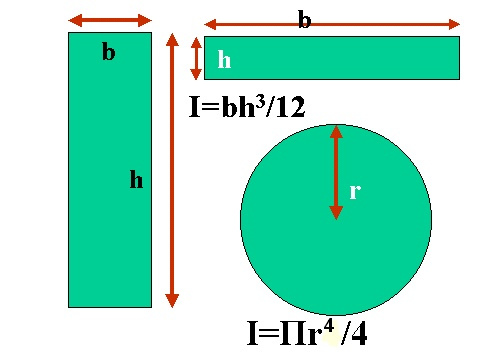
A 15ft Pram for Dinghy Cruising
20160601
20160701
20160711
20160801
20160901
20160915
20161201
20161215
20170107
20170113
20170114
20170119
20170120
20170122
20170123
20170131
20170208
20170219
20170220
20170221
20170224
20170225
20170318
20170328
20170329
20170408
20170409
20170417
20170420
20170421
20170422
20170423
20170424
20170425
20170426
20170427
20170501
20170509
20170521
20170525
<<
>>
20170219 |
|
In the Clinker Plywoord Boatbuilding Manual, Iain Oughtred proposes that the diameter of a solid unstayed round-sectioned wooden mast for a small boat should be 1:50 of LAD (length above deck). This is almost twice as big as the conventional mast of a racing dinghy. I guess the reason for this high value is that an unstayed mast should be extra stiff to cope with brutal downhaul needed in windy conditions. Working from this assumption, the mast of Hatseflats should have a diameter of 86mm based on 450cm LAD. The area will be app 58 cm2 (pi * r2). The area moment of inertia (I) is (r^4 * pi/4) = 43^4 * pi/4 = 2685120 mm4. Given a density of 0.5 the weight will be 2.9kg/m or 14.5kg for a solid untapered mast of 500cm. I like wood because it floats and is easy to work with. But nearly 15kgs for the mast alone is too much. 10-11kg would be acceptable but not much more. A solid square section of 75x75mm results in a marginally less stiff mast (I=bh^3/12). But with a weight of 14kg (2.81kg/m) this alternative is still too heavy.
A hollow wooden mast with the top half tapered to 70% should be a lot lighter.
This can be made with four tapered planks of 20mm around solid inserts.
For a concentric hollow square I = (BH^3 - bh^3)/12
The alternative is an untapered aluminium tube with a internal doubling in the lower 100cm.
The area moment of inertia of an annulus is (r2^4 - r1^4) * pi/4
Net weight is 5m * 2.04 = 10.2kg. With an inner sleeve for the lower 100cm, we arrive at 12.24kg. By using wood props in the ends we can even make it float. Links:
 20170219_formulae.jpg  20170219_tirrik3_03.jpg Tirrik built by De Zeeg. Alloy hull, alloy spars |